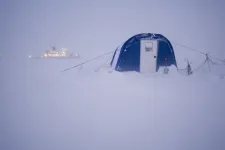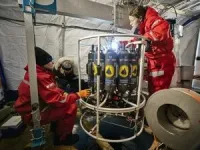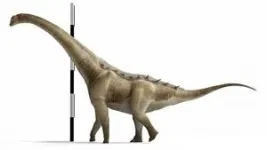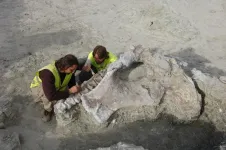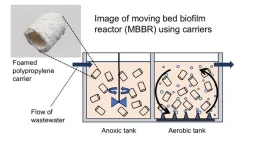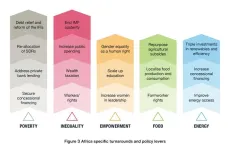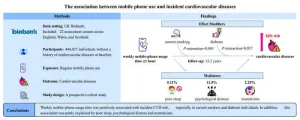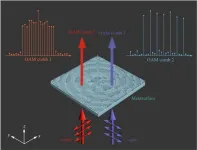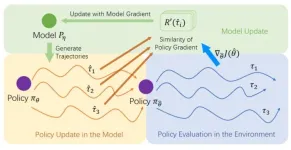(Press-News.org) Photosynthesis can take place in nature even at extremely low light levels. This is the result of an international study that investigated the development of Arctic microalgae at the end of the polar night. The measurements were carried out as part of the MOSAiC expedition at 88° northern latitude and revealed that even this far north, microalgae can build up biomass through photosynthesis as early as the end of March. At this time, the sun is barely above the horizon, so that it is still almost completely dark in the microalgae's habitat under the snow and ice cover of the Arctic Ocean. The results of the study now published in the journal Nature Communications show that photosynthesis in the ocean is possible under much lower light conditions, and can therefore take place at much greater depths, than previously assumed.
Photosynthesis converts sunlight into biologically usable energy and thus forms the basis of all life on our planet. However, previous measurements of the amount of light required for this have always been well above the theoretically possible minimum. A new study in the scientific journal Nature Communications shows that the build-up of biomass can actually take place with a quantity of light that is close to this minimum.
The researchers used data from the international MOSAiC research project for their work. As part of the expedition, they froze the German research icebreaker Polarstern in the icepack of the central Arctic for a year in 2019, in order to investigate the annual cycle of the Arctic climate and ecosystem. The team led by Dr Clara Hoppe from the Alfred Wegener Institute, Helmholtz Centre for Polar and Marine Research (AWI) focused on studying phytoplankton and ice algae. These are responsible for the majority of photosynthesis in the central Arctic. Unexpectedly, the measurements showed that just a few days after the end of the month-long polar night, plant biomass was built up again, for which photosynthesis is absolutely essential. Extremely sensitive light sensors in the ice and water made it possible to measure the amount of light available.
The results were particularly surprising because photosynthesis in the Arctic Ocean took place under snow-covered sea ice, which only allows a few photons of incident sunlight to pass through: The microalgae only had about one hundred thousandth of the amount of light of a sunny day on the Earth's surface available for their growth. "It is very impressive to see how efficiently the algae can utilise such low amounts of light. This shows once again how well organisms are adapted to their environment" says Clara Hoppe.
The study was made possible by the close collaboration of researchers from various disciplines. Sea ice researchers Dr Niels Fuchs and Prof Dirk Notz from the Institute of Marine Research at the University of Hamburg were responsible for combining measurements of the light field with the biological measurements. "To measure such low light levels under the harsh conditions of the Arctic winter, we had to freeze special, newly developed instruments into the ice in the middle of the polar night," explains Niels Fuchs. His colleague Dirk Notz adds that it was particularly difficult to take into account irregularities in the light field under the ice due to variations in ice thickness and snow: "But in the end we could be sure: There was just not more light."
The results of the now published study are important for the entire planet. "Even though our results are specific to the Arctic Ocean, they show what photosynthesis is capable of. If it is so efficient under the challenging conditions of the Arctic, we can assume that organisms in other regions of the oceans have also adapted so well," says Clara Hoppe, contextualising the results. This means that there could also be enough light to produce usable energy and oxygen through photosynthesis in deeper areas of the oceans, which would then be available for fish, for example. The corresponding photosynthetic habitat in the global ocean could therefore be significantly larger than previously assumed.
Original publication:
Clara J.M. Hoppe, Niels Fuchs, Dirk Notz, Philip Anderson, Philipp Assmy, Jørgen Berge, Gunnar Bratbak, Gaël Guillou, Alexandra Kraberg, Aud Larsen, Benoit Lebreton, Eva Leu, Magnus Lucassen, Oliver Müller, Laurent Oziel, Björn Rost, Bernhard Schartmüller, Anders Torstensson, Jonas Wloka: Photosynthetic light requirement near the theoretical minimum detected in Arctic microalgae, Nature Communications (2024). DOI: https://doi.org/10.1038/s41467-024-51636-8
Notes for editors:
Please note the publisher’s embargo: 11:00 CEST (10:00 am London Time) on Wednesday, 4 September 2024
Printable images are available until the embargo here: https://multimedia.awi.de/pincollection.jspx?collectionName=%7Bd5138955-7fcd-4792-a8db-bbeed9ffdfe9%7D, and afterwards in the online version of this press release at: https://www.awi.de/ueber-uns/service/presse.html
Follow the Alfred Wegener Institute on Instagram: @awiexpedition, LinkedIn: @Alfred Wegener Institute, Mastodon: @awi@helmholtz.social.de, Facebook: @AlfredWegenerInstitute and Youtube: @AWIresearch.
The Alfred Wegener Institute, Helmholtz Centre for Polar and Marine Research (AWI) conducts research in the Arctic, Antarctic and the oceans of the temperate and high latitudes. It coordinates polar research in Germany and provides important infrastructure such as the research icebreaker Polarstern and stations in the Arctic and Antarctic for international science. The Alfred Wegener Institute is one of the 18 research centres of the Helmholtz Association, Germany's largest scientific organisation.
END
Photosynthesis in near darkness
Research team publishes new results of the MOSAiC project
2024-09-04
ELSE PRESS RELEASES FROM THIS DATE:
Newly discovered viruses in parasitic nematodes could change our understanding of how they cause disease
2024-09-04
New research shows that parasitic nematodes, responsible for infecting more than a billion people globally, carry viruses that may solve the puzzle of why some cause serious diseases.
A study led by Liverpool School of Tropical Medicine (LSTM) used cutting-edge bioinformatic data mining techniques to identify 91 RNA viruses in 28 species of parasitic nematodes, representing 70% of those that infect people and animals. Often these are symptomless or not serious, but some can lead to severe, ...
Qunkasaura: New sauropod dinosaur from the Cretaceous discovered in the Iberian Peninsula
2024-09-04
A new study led by Portuguese paleontologist Pedro Mocho, from the Instituto Dom Luiz of the Faculty of Sciences of the University of Lisbon (CIÊNCIAS), has just been published in the Communications Biology journal, which announces a new species of sauropod dinosaur that lived in Cuenca, Spain, 75 million years ago: Qunkasaura pintiquiniestra.
The more than 12,000 fossils collected from 2007 onwards during works to install the Madrid-Levante high-speed train (AVE) tracks revealed this deposit, giving rise to one of the most relevant collections ...
Sports concussions in non-athletes not linked to long-term cognitive effects: study
2024-09-04
Sports-related concussions (SRC) may not be associated with long-term cognitive risks for non-professional athletes, a study led by a UNSW medical researcher suggests. In fact, study participants who had experienced an SRC had better cognitive performance in some areas than those who had never suffered a concussion, pointing to potential protective effects of sports participation.
Published in the Journal of Neurology, Neurosurgery and Psychiatry (JNNP), the research reveals that individuals who reported experiencing any SRC during their lifetime had a marginally better cognitive performance than those who reported no concussions.
The study, a collaboration ...
Spurring more biofilm growth for efficient wastewater treatment
2024-09-04
For the sake of the environment and our quality of life, effective treatment of wastewater plays a vital role. A biological method to treat sewage using moving, biofilm-covered plastic items known as carriers has been gaining prominence, and an Osaka Metropolitan University-led team has found ways to make the process more efficient.
The moving bed biofilm reactor (MBBR) process purifies wastewater by putting these carriers in motion to get the biofilm’s microorganisms into greater contact with organic matter and other impurities. The more biofilm that can be attached ...
In world 1st, high-quality feline iPSCs generated without genetic footprint
2024-09-04
A common image of cats today comes in the form of cute cat memes online, but these furry felines commonly experience kidney disease. Amid advances in medicine to improve people’s quality of life, an Osaka Metropolitan University-led team has, for the first time in the world, generated high-quality feline induced pluripotent stem cells (iPSCs), which have the potential to help companion animals and humans alike.
Human iPSCs have been generated using just four genes known as transcription factors, but feline iPSCs have been difficult to generate. Graduate School of Veterinary Science Professor Shingo Hatoya led the team in introducing six transcription factors via the Sendai virus ...
How Sub-Saharan Africa can achieve the SDGs by 2100: A new report by Earth4All
2024-09-04
In the best-case scenario, called the "Giant Leap," Sub-Saharan Africa could see poverty drop from 500 million to 25 million people, hunger nearly eradicated, and universal access to education, clean water, and sustainable electricity. On the other hand, the "Too Little Too Late" scenario paints a grim picture where poverty rises to 900 million, hunger still affects 180 million, and over a billion people lack clean water. The Too Little Too Late scenario is based on existing policies in the region. These two scenarios highlight the critical importance of action this decade to drive five extraordinary turnarounds in the areas of poverty, inequality, ...
New research shows regular mobile phone use can increase the risk of cardiovascular diseases, especially in smokers and people with diabetes
2024-09-04
Philadelphia, September 4, 2024 – A new study has found that regular mobile phone use was positively associated with incident cardiovascular diseases risk, especially in current smokers and individuals with diabetes. In addition, this association was partly attributed to poor sleep, psychological distress, and neuroticism. The article in the Canadian Journal of Cardiology, published by Elsevier, details the results of this large-scale prospective cohort study.
Yanjun Zhang, MD, Division of Nephrology, Nanfang Hospital, Southern Medical University, Guangzhou, China, explains, "Mobile phone use is a ubiquitous exposure in modern society, so exploring its impact on health has ...
Can you identify the new threat attracting Gen Z to nicotine use?
2024-09-04
COLUMBUS, Ohio – About half of adults can identify cigarettes and e-cigarettes, but just one in four would recognize oral nicotine pouches, and these easily available products are growing increasingly popular among teens and young adults, according to a recent study commissioned by The Ohio State University Comprehensive Cancer Center – Arthur G. James Hospital and Richard J. Solove Research Institute (OSUCCC – James).
Oral nicotine pouches are small packets filled with a flavored powder containing nicotine and other chemicals that are tucked between the lip and gums. ...
Generation and multiplexing of double-polarized terahertz vortex combs
2024-09-04
Introduction
As a new degree of freedom, the orbital angular momentum of electromagnetic waves exceeds the traditional frequency, phase, and amplitude, and is expected to promote the infinite expansion of channel capacity. Recently, a team of research professor Chao-Hai Du from Peking University and Professor Xiaofei Zang's research group from the University of Shanghai for Science and Technology have carried out in-depth cooperation. Based on the research foundation of both sides in the field of terahertz and metasurface, a new method of generating polarization-multiplexed terahertz vortex combs using all-silicon metasurface has been ...
A unified objective for dynamics model and policy learning in model-based reinforcement learning
2024-09-04
Recently, model-based reinforcement learning has been considered a crucial approach to applying reinforcement learning in the physical world, primarily due to its efficient utilization of samples. However, the supervised learned model, which generates rollouts for policy optimization, leads to compounding errors and hinders policy performance. To address this problem, the research team led by Yang YU published their new research on 15 August 2024 in Frontiers of Computer Science co-published by Higher Education ...
LAST 30 PRESS RELEASES:
What causes some people’s gut microbes to produce high alcohol levels?
Global study reveals widespread burning of plastic for heating and cooking
MIT study shows pills that communicate from the stomach could improve medication adherence
Searching for the centromere: diversity in pathways key for cell division
Behind nature’s blueprints
Researchers search for why some people’s gut microbes produce high alcohol levels
Researchers find promising new way to boost the immune response to cancer
Coffee as a staining agent substitute in electron microscopy
Revealing the diversity of olfactory receptors in hagfish and its implications for early vertebrate evolution
Development of an ultrasonic sensor capable of cuffless, non-invasive blood pressure measurement
Longer treatment with medications for opioid use disorder is associated with greater probability of survival
Strategy over morality can help conservation campaigns reduce ivory demand, research shows
Rising temperatures reshape microbial carbon cycling during animal carcass decomposition in water
Achieving ultra-low-power explosive jumps via locust bio-hybrid muscle actuators
Plant-derived phenolic acids revive the power of tetracycline against drug-resistant bacteria
Cooperation: A costly affair in bacterial social behaviour?
Viruses in wastewater: Silent drivers of pollution removal and antibiotic resistance
Sub-iethal water disinfection may accelerate the spread of antibiotic resistance
Three in four new Australian moms struggle with body image
Post-stroke injection protects the brain in preclinical study
Cardiovascular risk score predicts multiple eye diseases
Health: estimated one in ten British adults used or interested in GLP-1 medications for weight loss
Exercise to treat depression yields similar results to therapy
Whooping cough vaccination for pregnant women strengthens babies’ immune system
Dramatic decline in new cases of orphanhood in Uganda driven by HIV treatment and prevention programs
Stopping weight loss drugs linked to weight regain and reversal of heart health markers
Higher intake of food preservatives linked to increased cancer risk
Mass General Brigham–developed cholera vaccine completes phase 1 trial
First experimental validation of a “150-year-old chemical common sense” direct visualization of the molecular structural changes in the ultrafast anthracene [4+4] photocycloaddition reaction
Lack of support for people on weight loss drugs leaves them vulnerable to nutritional deficiencies, say experts
[Press-News.org] Photosynthesis in near darknessResearch team publishes new results of the MOSAiC project
